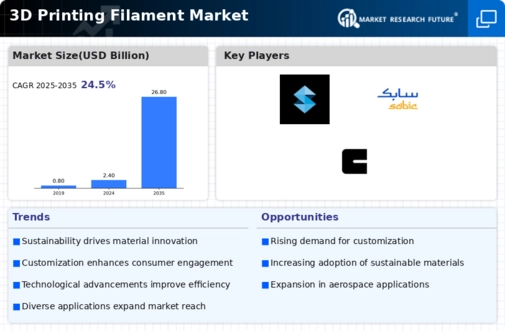Top Industry Leaders in the 3D Printing Filament Market

Strategies Shaping the Competitive Landscape:
-
Material Diversification: Beyond the dominant PLA, brands like BASF and Extrud3D are pushing boundaries with filaments like high-performance PEEK for aerospace applications, flexible TPE for wearables, and conductive filaments for electronic prototyping. This diverse palette widens the appeal of 3D printing to new industries.
-
Eco-Conscious Filament: Sustainability is the new filament color. Companies like PolyMaker and Filablend are leading the charge with recycled filaments, bio-based materials like wood-fill and bamboo, and water-soluble supports, minimizing environmental impact while aligning with the values of eco-conscious consumers.
-
Innovation and Differentiation: Chemical giants like Dow and Covestro are leveraging R&D to develop specialty filaments with unique properties, like glow-in-the-dark, color-changing, and flame-retardant options. Smaller players like Proto-Pasta and Proto-Pasta are finding their niche with filaments mimicking wood, metal, and concrete textures, pushing the boundaries of aesthetics and functionality.
-
Direct-to-Consumer Access: Bypassing middlemen, brands like Prusa Research and MatterHackers are establishing online stores and communities, building direct relationships with customers and offering personalized filament recommendations and support. This fosters brand loyalty and customer engagement.
-
Strategic Partnerships and Acquisitions: Collaboration is key. Filaments.ca recently partnered with BASF to distribute their high-performance filaments in Canada, while eSun acquired PolyTerra PLA manufacturer 3DFilament, expanding their reach and product portfolio. These moves accelerate market penetration and resource-sharing.
Factors Determining Market Share:
-
Filament Quality and Consistency: Reliable printing comes from consistent filament diameter, optimal flow, and minimal warping. Brands like eSUN and Fillamentum prioritize rigorous quality control, earning the trust of demanding users.
-
Material Properties and Application Versatility: Offering specialized filaments for specific uses, like food-safe PLA for kitchenware or conductive PLA for electronics, attracts dedicated customer segments. Brands like Proto-Pasta cater to hobbyists with unique filaments, expanding the market reach.
-
Price Competitiveness: Balancing quality with affordability is crucial. Established brands like Creality and Anycubic offer budget-friendly PLA filaments, attracting entry-level makers. Meanwhile, premium brands like ColorFabb and Black Magic justify their higher prices with exceptional performance and unique material blends.
-
Brand Reputation and Community Engagement: Actively participating in online communities, sponsoring events, and providing educational resources build brand recognition and customer loyalty. Companies like Prusa Research and MatterHackers excel in this, creating a strong community around their brand.
-
Innovation and New Product Development: Continuously expanding the filament portfolio with cutting-edge materials and functionalities keeps brands ahead of the curve. BASF's development of filaments for medical applications and PolyMaker's color-changing filaments are examples of staying ahead of the trend.
Key Companies in the 3D Printing Filament Market includes.
- Stratasys Ltd
- 3D Systems Corporation
- Arkema SA
- Materialise NV
- Evonik Industries AG
- Koninklijke Dsm N.V.
- SABIC
- Clariant
- HP Inc.
- Dow Inc.
Recent Developments:
October 2023: The Consumer Electronics Show (CES) showcases several advancements in 3D printing technology, including new filament materials, faster printers, and software innovations
November 2023: Prusa Research announces the open-source design for their own filament production printer, democratizing filament production.
December 2023: The 3D printing filament market shows signs of consolidation, with major acquisitions and mergers occurring as brands fight for market share.

